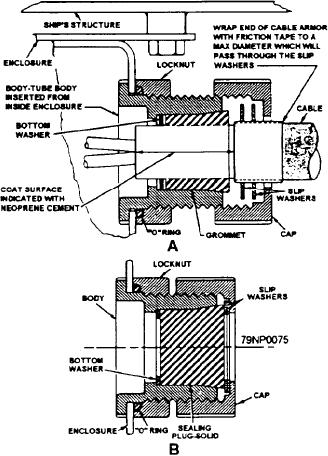
This allows a single-size stuffing tube to be used for a
of equipment enclosures. However, top entry into these
variety of cable sizes, and makes it possible for nine
enclosures should be made dripproof through stuffing
sizes of nylon tubes to replace 23 sizes of aluminum,
tubes or cable clamps sealed with plastic sealer.
steel, and brass tubes.
Uses below and above the Main Deck
The nylon stuffing tube is available in two parts.
The body, O-ring, locknut, and cap comprise the tube;
Below the main deck, stuffing tubes are used to
and the rubber grommet, two slip washers, and one
penetrate the following areas:
bottom washer comprise the packing kit.
Watertight decks
A nylon stuffing tube that provides cable entry into
an equipment enclosure is applicable to both watertight
Watertight bulkheads
and nonwatertight enclosures (fig. 2-28, view A). Note
Watertight portions of bulkheads that are
that the tube body is inserted from inside the enclosure.
watertight only to a certain height
The end of the cable armor, which will pass through the
slip washers, is wrapped with friction tape to a
Above the main deck, stuffing tubes have the
maximum diameter. To ensure a watertight seal, one
following uses for cable penetrations:
coat of neoprene cement is applied to the inner surface
Watertight or airtight boundaries
of the rubber grommet and to the cable sheath where it
will contact the grommet. After the cement is applied,
Bulkheads designed to withstand a waterhead
the grommet is immediate y slipped onto the cable. You
Portions of the bulkhead below the height of the
must clean the paint from the surface of the cable sheath
before applying the cement.
sill or coaming of compartment accesses
Flametight or gastight or watertight bulkheads,
Sealing plugs are available for sealing nylon
stuffing tubes from which the cables have been
decks, or wiring trunks within turrets or gun
mounts
Structures subject to sprinkling
Construction
Stuffing tubes are made of nylon, steel, brass, or
aluminum alloys. Nylon tubes have very nearly
replaced metal tubes for cable entry to equipment
enclosures. Cable penetration of bulkheads and decks
are normally of metal because of their integrity during
fires. Stuffing tubes made of metal are normally used
for cable penetration of bulkheads and decks. Nylon
stuffing tubes melt and fail to act as a barrier during a
fire.
The nylon stuffing tube is lightweight,
positive-sealing, and noncorrosive. It requires only
minimum maintenance for the preservation of
watertight integrity. The watertight seal between the
entrance to the enclosure and the nylon body of the
stuffing tube is made with a neoprene O-ring, which is
compressed by a nylon locknut. A grommet-type,
neoprene packing is compressed by a nylon cap to
accomplish a watertight seal between the body of the
tube and the cable. Two slip washers act as compression
washers on the grommet as the nylon cap of the stuffing
tube is tightened. Grommets of the same external size,
Figure 2-28.--Representative nylon stuffing tube installations.
but with different sized holes for the cable, are available.
2-26

